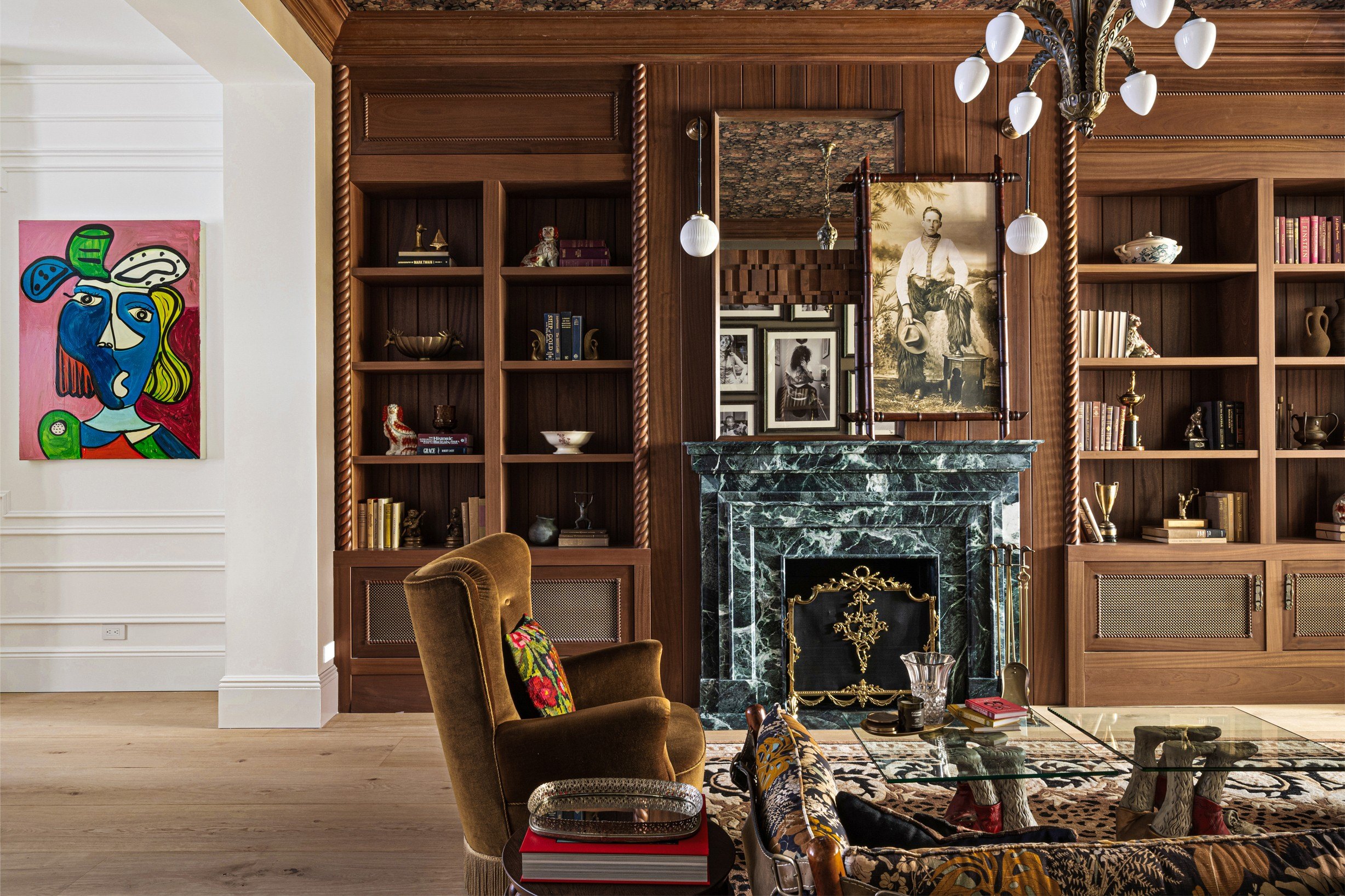Maximalism is having a moment. From design shows like Magnolia Network’s “Anything But Gray” (which features super colorful designs), to celebrity homes like Zooey Deschanel and Jonathan Scott’s bold New York apartment—maximalist style is making a comeback.
Maximalist interiors even made the Realtor.com® 30 fastest-rising home features of the last year.
Sara Simon, a designer and real estate agent in New York City, describes maximalism as more than just an aesthetic. “It’s really a declaration of self-expression,” she says. “It’s a curated collision of cherished belongings, bold color, pattern-on-pattern, and layered textures. Think of it as inviting all your favorite things to one fabulous, slightly chaotic, and utterly personal party.”
She adds that a truly successful maximalist space is one that “feels rich with story and personality.”
But maximalism isn’t for everyone. Jennifer Jones, principal designer of Niche Interiors based in San Francisco, says the trend is simply too loud and over-the-top. She admits: “I can’t stand it.”
“Maximalist rooms tend to feel chaotic: Your eye is distracted by bold wallpaper, patterned drapes and upholstery, and way too many accessories,” she says. While she acknowledges the style can work for transitional spaces, such as a foyer or a hotel lobby, it “is much less successful for rooms you want to spend real time in.”
So, is maximalist style a yay or nay? Experts say the look has grown in popularity, and while it may not impress everyone, a well-curated maximalist style could help sell your house. Here’s everything you need to know about the trend.
What is maximalist design?
Maximalist is all about being playful, vibrant, and not holding back. It often includes statement wallpaper, colorful rugs, and unique decor all working together to create a space that’s both exciting and personal.
Sometimes maximalism feels cozy—think of the stereotypical “Granny’s house” filled with cat portraits and floral prints. Other times it’s regal, with big chandeliers and elegant antiques. The idea of maximalism is “more is more”—whatever that means to an individual.
“I like to think of maximalism as an abundance of the homeowner’s personality,” says Sarah Caswell, head of interior design at real estate brokerage SoldFast. “They have a favorite everything, whether that be color, texture, or motif, and want to put that on display.”
Why is maximalism trending?
Marianne Jones, a California-based interior designer, isn’t surprised maximalist designs are trending.
“Interior design, much like fashion, reflects the cultural moment we’re living through. The deprivation and isolation of COVID created a profound shift in how we relate to our homes,” she explains. “People aren’t just wanting more—they’re craving warmth, tactility, and connection to something that feels human and lived-in rather than styled. There’s a pull toward comfort and a gentler aesthetic that speaks to a deeper need for sanctuary.”
Simon agrees, saying that during the pandemic, those who had simple, minimalist spaces likely got bored of them quickly.
“When the world became our office, our classroom, and our social hub, the home needed to work harder,” says Simon. “I think people quickly realized a minimalist backdrop was boring to look at for 16 hours a day. Maximalism gives us those joyful, rich visual moments that keep us engaged and inspired while we’re home.”
Maximalist designs have come into and out of fashion before, but this time, Marianne Jones is noticing that the collection and presentation is more intentional. “After years of minimalist interiors, we’re witnessing a genuine hunger for personality and depth,” she says. “Mixing patterns, displaying collected objects, and embracing color and texture isn’t a throwback—it’s how meaningful spaces have always been created, layer by layer, over time.”
(Joseph Velasquez/Five7 Media)

Getting the look
Maximalism might look enticing for some, Caswell notes, but she says the style isn’t something you want to rush into. That is, she doesn’t want homeowners to run out and grab a bunch of “stuff” to fill their home. “The best maximalist spaces are carefully curated over the years, with most pieces holding some kind of sentimental value,” she says.
But if you want to try the maximalist look, Caswell has some tips. For one thing, she says to keep one or two colors or textures consistent throughout the space, which she says will make the space feel more grounded and cohesive.
Second, she says it’s good to mix in some plain with the pops. “Subtle textures like stone or canvas add to the variety without making a space feel too cluttered,” she says.
Finally, she says maximalism isn’t necessarily about stuffing as much into a design as possible. She recommends leaving some white or empty space. “Something of a gallery wall,” Caswell adds.
Simon also encourages people to let loose a little. She suggests mixing metals and getting playful with paint. “Stop being so matchy matchy,” she says. “There are no rules—you make your own.”
How is maximalism received on the market?
For years, we’ve been told that for-sale homes should feel simple, accessible, and pleasing to the masses. But lately, the market has shown that sometimes the opposite is true, with many buyers being charmed by unique and custom home designs.
In fact, according to Realtor.com research, 54.8% more listings in 2025 mentioned maximalist in their descriptions than did in 2024. While still pretty rare, it’s clearly on the upswing.
So, could maximalism help sell your house? Caswell says: maybe, maybe not.
“Some potential buyers struggle to see themselves in houses when they’re covered floor to ceiling with someone else’s life,” Caswell says. “At the same time, other buyers are drawn to the authenticity and character, and are eager to see what their own spin on the style will be.”
Eric Field, founder and real estate expert at Big Door Home Buyers in Northbrook, IL, says he’s been seeing more and more for-sale homes with maximalist style, particularly in trendy areas. He admits maximalism isn’t everyone’s cup of tea, but a unique style can help make a home stand out.
“Purchasers are no longer afraid of a ‘busy’ design, if it’s genuine,” Field says. “I’ve had consumers exclaim, ‘This home is alive!’ when touring a maximalist interior design. This emotional response can actually sell a house faster, even if it is not every person’s design preference.”
He adds that the maximalist homes that do best are those with plenty of lighting. “We want to draw buyers in, not wear them out,” he says.
Caswell has also noticed that buyers seem to prefer maximalism in newer homes with open floor plans. “Older, historic properties have smaller room sizes that can make maximalism feel overwhelming,” Caswell says.
Meanwhile, Jennifer Jones says that while some sellers might find success offloading their maximalist homes, she thinks the design style appeals to “a very small subset” of potential buyers. “In general, the goal is for buyers to notice the appealing features of the home such as the architectural details or open layout, not the existing homeowner’s over-the-top design style or furnishings,” she says.
So, while maximalism might help your home stand out, it might not be your best selling strategy.
If maximalism is not considered a “win” across the board, Marianne Jones says simply seeing the style come back should be counted as a success.
“Right now, we’re seeing an extraordinary range of styles coexisting in both fashion and interior design,” she says. “That diversity itself signals something important: We’ve moved beyond the idea of one ‘correct’ aesthetic. People are giving themselves permission to create spaces that feel personally resonant rather than culturally prescribed.”

